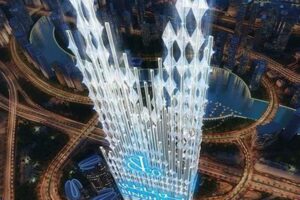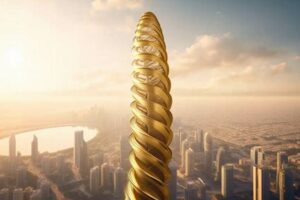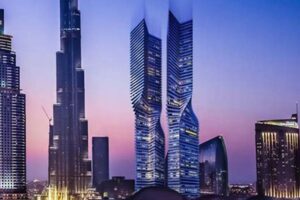Dubai, a city renowned for its architectural marvels, boasts an impressive skyline adorned with towering skyscrapers that have reshaped the urban landscape. These skyscrapers, marvels of engineering and architectural ingenuity, have become synonymous with Dubai’s identity and serve as a testament to the city’s relentless pursuit of progress and innovation.
The skyscrapers of Dubai are not merely tall structures; they are architectural masterpieces that push the boundaries of design and functionality. They house world-class hotels, luxurious residences, cutting-edge offices, and state-of-the-art shopping malls, creating vibrant vertical communities that cater to every need and desire. These skyscrapers have played a pivotal role in transforming Dubai into a global hub for business, tourism, and luxury living.
The Burj Khalifa, the tallest building in the world, stands as a beacon of Dubai’s architectural prowess. Its sleek silhouette and breathtaking height have made it an iconic landmark, attracting visitors from around the globe. Other notable skyscrapers include the Princess Tower, the 23 Marina, and the Cayan Tower, each showcasing unique architectural styles and innovative features. These skyscrapers have not only redefined the city’s skyline but have also contributed to Dubai’s reputation as a city of architectural wonders.
1. Height
The height of Dubai’s skyscrapers, exemplified by the Burj Khalifa, is a defining characteristic that sets them apart and contributes to their global recognition. Here’s a closer look at the significance of height in the context of Dubai’s skyscrapers:
- Engineering Prowess: Constructing skyscrapers of such immense height requires exceptional engineering expertise and innovation. The Burj Khalifa’s structural design, wind engineering, and use of advanced materials showcase the pinnacle of human engineering capabilities.
- Vertical Living: Extreme height allows for the creation of vertical communities within skyscrapers, maximizing space utilization and fostering a sense of community among residents. These communities offer a range of amenities, from residential units to retail and leisure facilities, all within a single high-rise structure.
- Economic Growth: The construction and maintenance of skyscrapers contribute significantly to Dubai’s economy. They generate employment opportunities, attract foreign investment, and boost the real estate sector, driving economic growth and prosperity.
- Global Recognition: The height of Dubai’s skyscrapers has garnered worldwide attention and recognition. The Burj Khalifa, in particular, has become an iconic landmark, symbolizing Dubai’s ambition, innovation, and status as a global metropolis.
In conclusion, the height of Dubai’s skyscrapers, as exemplified by the Burj Khalifa, is not merely a physical attribute but a testament to human ingenuity, engineering prowess, and economic vision. These skyscrapers have transformed Dubai’s skyline, fostered vertical living communities, contributed to economic growth, and placed the city on the global map as a symbol of architectural achievement.
2. Design
The design of Dubai’s skyscrapers is a key factor that sets them apart and contributes to their global recognition. From the sail-shaped Burj Al Arab to the twisted Cayan Tower, each skyscraper showcases a unique architectural style that reflects Dubai’s ambition, innovation, and cultural diversity.
- Iconic Landmarks: The unique designs of Dubai’s skyscrapers have created iconic landmarks that are instantly recognizable around the world. The Burj Khalifa, with its sleek and soaring silhouette, and the Burj Al Arab, with its distinctive sail-like shape, have become symbols of Dubai’s architectural prowess and global standing.
- Cultural Influences: The design of Dubai’s skyscrapers often incorporates elements of Islamic architecture and traditional Arabic design. This blend of modern and traditional styles creates a unique aesthetic that reflects Dubai’s cultural heritage while embracing contemporary architectural trends.
- Innovation and Experimentation: Dubai’s skyscrapers are a testament to the city’s willingness to embrace innovation and experimentation in architecture. The twisted Cayan Tower, with its helical shape, and the Infinity Tower, with its infinity symbol-shaped pool, push the boundaries of architectural design and engineering.
- Sustainable Design: Sustainability is an increasingly important consideration in the design of Dubai’s skyscrapers. Many of these buildings incorporate energy-efficient features, such as solar panels and wind turbines, to reduce their environmental impact.
In conclusion, the unique architectural styles of Dubai’s skyscrapers are a reflection of the city’s ambition, innovation, and cultural diversity. These skyscrapers have not only transformed Dubai’s skyline but have also become iconic landmarks that symbolize the city’s global standing and its commitment to architectural excellence.
3. Engineering
Engineering plays a critical role in the construction and maintenance of Dubai’s skyscrapers, ensuring their structural integrity and sustainability. Advanced engineering techniques are employed to withstand the unique challenges posed by these towering structures.
- Wind Engineering: Dubai’s skyscrapers are subjected to strong winds due to their height and proximity to the Arabian Gulf. Advanced wind engineering techniques, such as wind tunnel testing and computational fluid dynamics, are used to analyze wind patterns and design buildings that can withstand high wind loads.
- Structural Integrity: The immense height and weight of Dubai’s skyscrapers require robust structural systems to ensure their stability and safety. Engineers employ advanced materials, such as high-strength concrete and steel, along with innovative structural designs, to create buildings that can withstand earthquakes, strong winds, and other potential hazards.
- Sustainability: Dubai is committed to sustainable development, and its skyscrapers incorporate various green building technologies to reduce their environmental impact. These technologies include energy-efficient lighting systems, solar panels, and water conservation systems, ensuring that these buildings operate sustainably.
- Fire Safety: Fire safety is paramount in high-rise buildings. Dubai’s skyscrapers are equipped with advanced fire safety systems, including fire sprinklers, smoke detectors, and fire-resistant materials, to protect occupants and minimize damage in the event of a fire.
In conclusion, the advanced engineering techniques employed in Dubai’s skyscrapers ensure their structural integrity, sustainability, and safety. These engineering marvels not only redefine the city’s skyline but also set new standards for high-rise construction worldwide.
4. Purpose
The purpose of Dubai’s skyscrapers extends beyond their architectural grandeur and engineering prowess. These towering structures are not merely symbols of ambition and innovation; they are vibrant hubs of commerce, hospitality, and luxury living. The diverse range of uses housed within Dubai’s skyscrapers plays a crucial role in shaping the city’s identity and economy.
World-class Hotels: Dubai’s skyscrapers are home to some of the world’s most luxurious and iconic hotels. These hotels offer unparalleled levels of service, amenities, and accommodations, catering to discerning travelers and business elites. The presence of these world-class hotels has transformed Dubai into a global tourism destination, attracting visitors from around the world.
Luxury Residences: Dubai’s skyscrapers offer a wide range of luxury residential options, from spacious apartments to opulent penthouses. These residences provide residents with stunning views of the city skyline, access to exclusive amenities, and the highest standards of comfort and security. The availability of luxury residences has made Dubai a desirable destination for wealthy individuals and families seeking a sophisticated and cosmopolitan lifestyle.
Cutting-edge Offices: Dubai’s skyscrapers house cutting-edge offices that meet the demands of modern businesses. These offices are equipped with state-of-the-art technology, flexible workspaces, and collaborative environments. The presence of these offices has attracted multinational corporations, financial institutions, and tech startups, contributing to Dubai’s growing reputation as a global business hub.
In conclusion, the diverse purpose of Dubai’s skyscrapers, housing world-class hotels, luxury residences, and cutting-edge offices, is integral to the city’s economic growth, tourism industry, and global standing. These skyscrapers are not just architectural marvels; they are dynamic centers of commerce, hospitality, and luxury living, shaping Dubai’s identity as a vibrant and cosmopolitan metropolis.
5. Community
In the context of Dubai’s skyscrapers, vertical communities within these towering structures play a significant role in fostering a sense of belonging and convenience for residents. These communities, often referred to as “vertical villages,” offer a unique blend of privacy and communal living, along with an array of amenities and services that cater to the diverse needs of their residents.
- Shared Amenities and Spaces: Vertical communities within skyscrapers provide residents with access to shared amenities and spaces, such as swimming pools, fitness centers, landscaped gardens, and recreational areas. These shared spaces encourage interaction among residents, fostering a sense of community and belonging.
- Convenient Lifestyle: Living in a vertical community offers residents convenience and ease of access to essential services and amenities. Many skyscrapers house retail outlets, restaurants, cafes, and other conveniences on their lower floors or within the podium levels, providing residents with the convenience of having these services right at their doorstep.
- Security and Privacy: Vertical communities within skyscrapers offer a high level of security and privacy for residents. These buildings are typically equipped with advanced security systems, including 24/7 surveillance, controlled access, and intercom systems, ensuring the safety and privacy of residents.
- Sense of Community: Vertical communities within skyscrapers foster a sense of community among residents. The close proximity of neighbors and the shared amenities create opportunities for social interaction and the development of strong bonds between residents, fostering a sense of belonging and support.
In conclusion, vertical communities within Dubai’s skyscrapers contribute significantly to the sense of belonging and convenience experienced by residents. These communities offer a unique blend of privacy, convenience, security, and a sense of community, making them highly desirable places to live for individuals and families alike.
6. Tourism
The iconic skyscrapers of Dubai play a pivotal role in attracting tourists from around the world, contributing significantly to the city’s thriving tourism sector. These architectural marvels have become synonymous with Dubai’s identity and are major attractions for both leisure and business travelers.
One of the most prominent examples is the Burj Khalifa, the world’s tallest building. This iconic landmark offers breathtaking views of the city from its observation deck, At the Top, attracting millions of visitors each year. Other skyscrapers, such as the Burj Al Arab, the Palm Jumeirah, and the Dubai Frame, have also become popular tourist destinations, offering unique experiences and photo opportunities.
The presence of these iconic skyscrapers has helped to position Dubai as a global tourism hub. Visitors are drawn to the city to witness these architectural wonders firsthand, contributing to the local economy through hotel stays, dining, shopping, and other tourism-related activities. The revenue generated from tourism supports various sectors of the economy, including hospitality, transportation, and retail, creating employment opportunities and driving economic growth.
Furthermore, the iconic skyscrapers of Dubai have played a significant role in enhancing the city’s global image and reputation. The architectural prowess and innovation showcased in these buildings have garnered international recognition and placed Dubai on the map as a modern and forward-thinking metropolis. This positive perception has attracted businesses, investors, and skilled professionals to the city, further contributing to its economic development.
In conclusion, the connection between “Tourism: Iconic landmarks attract visitors from around the globe, boosting Dubai’s tourism sector” and “skyscrapers dubai” is undeniable. The iconic skyscrapers of Dubai serve as major tourist attractions, drawing visitors from around the world and contributing significantly to the city’s economy and global standing.
7. Symbol of Progress
The skyscrapers of Dubai are not merely architectural marvels; they are powerful symbols of the city’s relentless pursuit of innovation and progress. These towering structures represent Dubai’s ambition to push boundaries, embrace modernity, and establish itself as a global hub for business, tourism, and innovation.
- Architectural Innovation: Dubai’s skyscrapers showcase cutting-edge architectural designs and engineering feats. The Burj Khalifa, the world’s tallest building, is a testament to the city’s commitment to innovation and its ability to challenge the limits of construction. Other skyscrapers, such as the Cayan Tower with its unique twisted shape, further demonstrate Dubai’s willingness to embrace bold and innovative architectural concepts.
- Economic Growth: The construction and maintenance of skyscrapers contribute significantly to Dubai’s economy. These projects create employment opportunities, boost the real estate sector, and attract foreign investment. The presence of iconic skyscrapers has also helped to establish Dubai as a global business hub, drawing multinational corporations and entrepreneurs from around the world.
- Global Recognition: Dubai’s skyscrapers have garnered worldwide attention and recognition, becoming iconic landmarks that symbolize the city’s ambition and modernity. The Burj Khalifa, in particular, has become a global icon, featured in countless media outlets and attracting visitors from around the world.
- Inspiration and Ambition: The skyscrapers of Dubai serve as a source of inspiration and aspiration for people around the world. They demonstrate the power of human ingenuity and the ability to achieve remarkable feats through innovation and determination. Dubai’s skyscrapers continue to inspire architects, engineers, and urban planners, pushing the boundaries of what is possible in the realm of construction and design.
In conclusion, the connection between “Symbol of Progress: Skyscrapers embody Dubai’s relentless pursuit of innovation and progress” and “skyscrapers dubai” is deeply intertwined. Dubai’s skyscrapers are not just buildings; they are symbols of the city’s ambition, innovation, and unwavering commitment to progress. They represent Dubai’s desire to make its mark on the world stage and to establish itself as a global leader in architecture, business, and innovation.
Frequently Asked Questions about Skyscrapers in Dubai
This section addresses common questions and misconceptions surrounding the iconic skyscrapers of Dubai, providing informative answers based on factual information.
Question 1: What is the tallest building in Dubai?
Answer: The Burj Khalifa, standing at an impressive 828 meters (2,717 feet), holds the title of the tallest building in Dubai and the world.
Question 2: Are all skyscrapers in Dubai residential buildings?
Answer: No, while many skyscrapers in Dubai feature residential units, they also house a diverse range of uses, including world-class hotels, cutting-edge offices, retail outlets, and entertainment venues.
Question 3: Are Dubai’s skyscrapers earthquake-proof?
Answer: Yes, Dubai’s skyscrapers are designed and constructed to withstand earthquakes. Advanced engineering techniques and stringent building codes ensure their structural integrity and safety during seismic events.
Question 4: Do skyscrapers in Dubai have sustainable features?
Answer: Yes, many skyscrapers in Dubai incorporate sustainable design elements, such as energy-efficient lighting systems, solar panels, and water conservation systems, to reduce their environmental impact and promote sustainable practices.
Question 5: Are there public observation decks in Dubai’s skyscrapers?
Answer: Yes, several skyscrapers in Dubai offer public observation decks, including the Burj Khalifa’s “At the Top” observation deck, which provides breathtaking panoramic views of the city from its elevated vantage point.
Question 6: What is the purpose of the wind turbines on some Dubai skyscrapers?
Answer: Some skyscrapers in Dubai are equipped with wind turbines to generate renewable energy and reduce their reliance on traditional energy sources. This contributes to Dubai’s efforts towards sustainability and environmental conservation.
In summary, Dubai’s skyscrapers are not just architectural marvels but also symbols of innovation, sustainability, and the city’s unwavering pursuit of progress. Their diverse uses, advanced engineering, and commitment to sustainability make them a testament to Dubai’s ambition and its status as a global hub for business, tourism, and innovation.
Transition to the next article section…
Tips for Visiting Dubai’s Skyscrapers
When visiting the iconic skyscrapers of Dubai, there are several tips to enhance your experience and ensure a memorable and safe visit.
Tip 1: Book Observation Deck Tickets in Advance:
To avoid long queues and secure your spot, book tickets for observation decks, such as “At the Top” in the Burj Khalifa, well in advance, especially during peak tourist seasons.
Tip 2: Visit During Off-Peak Hours:
If possible, plan your visit during off-peak hours or weekdays to avoid crowds and enjoy a more tranquil experience with fewer people.
Tip 3: Check the Weather Forecast:
Dubai’s weather can be unpredictable, especially during summer months. Check the weather forecast before your visit and dress accordingly. Consider sunglasses and sunscreen to protect yourself from the strong sun.
Tip 4: Respect Cultural Customs:
Dubai is a culturally diverse city. Be respectful of local customs and dress modestly when visiting public areas, including inside skyscrapers.
Tip 5: Allow Ample Time for Exploration:
Skyscrapers in Dubai are vast and offer multiple attractions. Allow ample time to explore each building, including its observation decks, shopping malls, and other amenities.
Tip 6: Take Advantage of Guided Tours:
Guided tours are an excellent way to learn about the history, architecture, and engineering behind Dubai’s skyscrapers. Consider booking a tour for a more immersive experience.
Tip 7: Capture Panoramic Views:
Don’t forget to capture the breathtaking panoramic views from the observation decks. Bring a camera or smartphone with a good lens to capture the stunning cityscapes.
Tip 8: Enjoy the Ambiance:
Beyond the architectural marvels, skyscrapers in Dubai offer a vibrant atmosphere. Take time to relax in the luxurious lounges, enjoy fine dining experiences, or simply soak in the ambiance of these iconic structures.
By following these tips, you can maximize your visit to Dubai’s skyscrapers, ensuring a safe, enjoyable, and memorable experience.
Transition to the article’s conclusion or next section…
Skyscrapers of Dubai
The skyscrapers of Dubai stand as testaments to the city’s relentless pursuit of innovation, progress, and architectural excellence. These iconic structures have transformed Dubai’s skyline, attracting global recognition and contributing significantly to its economic growth and tourism industry. Their unique designs, advanced engineering, and diverse uses have made them symbols of modernity and ambition, inspiring architects, engineers, and urban planners worldwide.
From the towering height of the Burj Khalifa to the innovative design of the Cayan Tower, Dubai’s skyscrapers showcase the pinnacle of architectural achievement. They embody the city’s commitment to sustainability, incorporating eco-friendly features to reduce their environmental impact. As vertical communities, these skyscrapers foster a sense of belonging and convenience, offering residents a unique blend of privacy and communal living. Their iconic status has positioned Dubai as a global hub for business, tourism, and luxury living.
As Dubai continues to push the boundaries of architectural innovation, its skyscrapers will undoubtedly remain at the forefront of design and engineering. They serve as a reminder of the city’s unwavering ambition and its dedication to shaping the future of urban living. The skyscrapers of Dubai are not just buildings; they are symbols of a city that dares to dream big and strives for the extraordinary.







